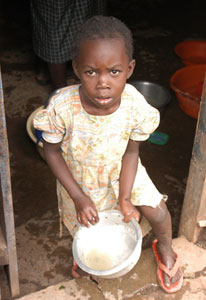Study probes link between intestinal infections, child development
November / December 2014 | Volume 13, Issue 6
One in five children in developing countries experiences malnutrition, which is linked to physical and cognitive impairment and greater risk of early death. Many undergo repeated bouts of diarrheal disease, but the role this plays in their development is not well understood. Scientists hypothesize that childhood gut infections cause intestinal dysfunction that negatively impacts nutrient absorption, leading to stunted growth and cognitive deficits. They also suspect that repeated infections, combined with malnutrition, can undermine the effectiveness of vaccines.

Photo by Felix Masi,
courtesy of Photoshare
The global MAL-ED project is examining
the link between intestinal infection and
malnutrition, which can permanently
undermine physical and cognitive
development in early childhood.
To investigate these and other related issues, an international network of scientists was formed to conduct an unprecedented study of early childhood in eight countries on three continents. They describe their approach, methodology and tools in a series of articles recently published as a supplement to the Clinical Infectious Diseases journal. The $40 million project, "Etiology, Risk Factors and Interactions of Enteric Infections and Malnutrition and the Consequences for Child Health (MAL-ED)," is led by Fogarty and the Foundation for the NIH (FNIH), with funding from the Bill and Melinda Gates Foundation.
"As a central objective of MAL-ED, untangling the complicated web of malnutrition and enteric disease is considered a crucial factor in the development of interventions that will improve child health in resource-poor environments," the study investigators note in the overview article.
The team, which began the study in 2009, chose urban and rural communities in countries where diarrheal diseases and malnutrition are common - Bangladesh, Brazil, India, Nepal, Pakistan, Peru, South Africa and Tanzania - and standardized study protocols so the results could be compared. The researchers enrolled more than 200 children in each location and followed them for the first two years of life, when many developmental milestones occur.
The scientists took a holistic approach with a community-based, longitudinal design and selection of geographically, socioeconomically and culturally diverse populations. They periodically measured the children's growth and cognitive progress and collected a wide range of data on diarrheal diseases and other potential influences such as nondiarrheal diseases, vaccines administered, micronutrient levels, diet, socioeconomic status, gut function and environment.
Surveillance was intense, with each child's home visited twice weekly. In addition, there was monthly collection of stool samples and information on a range of potential influences on the children's growth. Among them were early termination of breast-feeding, introduction of pathogens to the baby via solid foods, micronutrient status, inadequate diversity of foods and the state of their gut flora. Researchers also measured language development, maternal depressive symptoms, maternal reasoning abilities, child temperament and home environment. Armed with such comprehensive data, scientists can determine "individual, site-specific and general recommendations regarding the nature and timing of possible interventions," the MAL-ED authors said.
As well as the overview article, the supplement provides descriptions of activities at each field site and data collection methodologies used. These include an analysis of a biomarker test for detecting gut absorption and permeability, the use of infectious disease histories to signal the ages when child health is most vulnerable to infectious diseases, and the reasoning behind the choice of microbiologic assays and methodologies. Researchers also described the need to collect stool samples from asymptomatic children, both to capture those infections which produce no clinical symptoms and to gauge the main causes of intestinal infection within the community. In addition, they broached the understudied topic of how children in these diverse epidemiological settings might respond poorly to vaccines, which have been proven effective in populations in high-resource countries.
The study aims to provide important guidance for policymakers considering the optimal timing and targeting of interventions to achieve the maximum benefit. "Improvements in early childhood growth and development can have a long-lasting impact, through improved school readiness, educational achievement, and ultimately, improving the economic potential for individuals and their communities," the MAL-ED investigators concluded.
More Information
To view Adobe PDF files,
download current, free accessible plug-ins from Adobe's website.